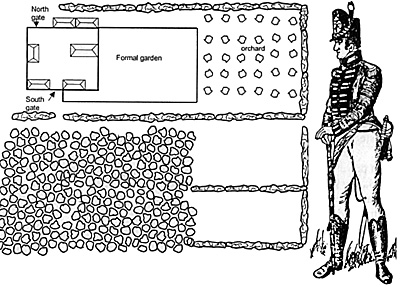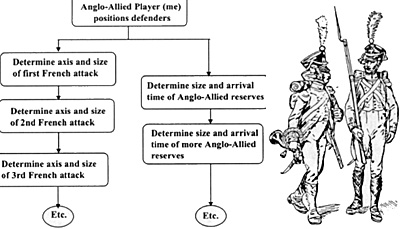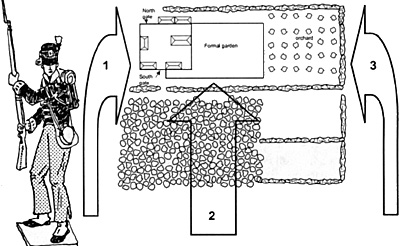I first visited the Waterloo battlefield in 1973 while stationed in Germany with the 8'h Infantry Division. The Napoleonic Wars were a mandatory course of study in my cadet days so here was my opportunity to see this place for myself My wife still kids me that I took her to a battlefield on our honeymoon. I don't get it.
 Anyway, we walked much of the area. I was thoroughly disgusted that the government had defaced the area by scraping away the ridge line to erect the Butte. Also, I found it
unsettling that so much of this most famous battlefield was unpreserved and in private hands. I guess I had been spoiled by the state of battlefields in the U.S. which are remarkably well preserved by the standards of the rest of the world. However, the Hougomont and La Haye Sainte were not open to the public so we could only view the outside. I purchased a quantity of 1/32 and 1/72 scale figures, returned to our casement in Germany, and painted and wargamed for the next two years before returning to Fort Knox.
Anyway, we walked much of the area. I was thoroughly disgusted that the government had defaced the area by scraping away the ridge line to erect the Butte. Also, I found it
unsettling that so much of this most famous battlefield was unpreserved and in private hands. I guess I had been spoiled by the state of battlefields in the U.S. which are remarkably well preserved by the standards of the rest of the world. However, the Hougomont and La Haye Sainte were not open to the public so we could only view the outside. I purchased a quantity of 1/32 and 1/72 scale figures, returned to our casement in Germany, and painted and wargamed for the next two years before returning to Fort Knox.
Years later, when I was assigned as an exchange instructor to the Canadian Forces Command and Staff College in Toronto, we took a two-week trip to Europe to visit various NATO headquarters. On my free time I visited the Belgian War Museum's extensive Napoleonic era collection in Brussels. The staff college conducted a trip to Waterloo as part of the curriculum. In the intervening years since my first visit, I had built up a serious collection of "small 25mm" Napoleonic wargame figures, including a large segment of Waterloo campaign regiments and brigades. The visit was conducted by a Canadian officer who was stationed in Belgium and who was intimately familiar with the Waterloo campaign and battlefield. As I prided myself in knowing a little about the subject, I volunteered to head up one of the three groups. The Canadians had secured permission to enter the Hougoumont grounds and I was thrilled at the once in a lifetime opportunity. So, there I was standing at the north gate explaining how Lieutenant Legros forced his way into the courtyard at the head of a small force of forty infantry and how the battle for the Chateau hinged upon the desperate struggle to close the doors behind him. Into the Hougomont complex we strode, examining the buildings, discussing the lore, analyzing the impact of this comer of the battlefield on the entire battle. It was an historian's dream. And I must admit, the staff college students were caught up in the spirit as well, many revealing that they were only vaguely aware of the battle activity but that this visit was a real "eye opener."
One of my many wargame projects has been to recreate the fight at the Hougoumont. I finally had the figures, it was time to work on the rules. As is much of my work, this would be a solo project. However, there appears to be some potential for a convention game as well. Everyone is active all the time, not unlike George Knapp's fast and furious Alamo game which I enjoy so much.
As many of you will know, the grounds around the "Chateau de Goumont" have changed considerably since 1815. The hedges and woods have been reconfigured entirely. The map shows my battlefield reconstruction of the grounds which is representative of the 1815 appearance.
HISTORICAL CONTEXT
Hougoumont served to anchor Wellington's otherwise open right flank. Situated, as it was, below and well in front of the ridge line, it could break up a French attack on that flank. Complemented by La Haye Sainte, these two forward positions channeled French attacks on the right of the Anglo-Allied army into a fairly narrow corridor with scant room for maneuver. If the Hougoumont were in French hands, they would be able to more securely approach Wellington's right flank.
While all this made it important for Wellington to retain Hougournont, Napoleon had other ideas. Napoleon hoped to break Wellington's center. To this end, it would do well for the French to thin out Wellington's forces in the center. Apparently Napoleon believed that a determined attack on the Hougoumont would draw Wellington's attention and reserves away from the decisive center.
Historians tell us that the reality differed from the plan. It appears that Wellington was able, by design or circumstances, to demonstrate an economy of force. Fewer Anglo-Allied than French forces were drawn into the fight for the chateau and surrounding defenses. The French effort, which started out as a diversionary measure, grew a life of its own, absorbing French infantry that would have been more usefully spent elsewhere.
THE WARGAME
 I don't know about the rest of you, but I think that this engagement has real potential for anentertaining fight. I so enjoy the figures: French, British, Nassau, KGL, Hanoverian, Brunswick, Dutch-Belgian. I wish I had a better model of the chateau and grounds. I used that most versatile of all wargame terrain medias, Legos, to build precisely the buildings and walls I wanted. Lichen did well for hedges. The entire chateau and grounds occupied about a third of
my 4 x 8 table. This was fine, as it focused the action at fairly close range. This would be a
knock-down brawl and that was okay.
I don't know about the rest of you, but I think that this engagement has real potential for anentertaining fight. I so enjoy the figures: French, British, Nassau, KGL, Hanoverian, Brunswick, Dutch-Belgian. I wish I had a better model of the chateau and grounds. I used that most versatile of all wargame terrain medias, Legos, to build precisely the buildings and walls I wanted. Lichen did well for hedges. The entire chateau and grounds occupied about a third of
my 4 x 8 table. This was fine, as it focused the action at fairly close range. This would be a
knock-down brawl and that was okay.
After extensive reading on the subject, I figured out what factors I wanted to leave to chance. I wanted to play the role of the defender of the Chateau and grounds. As the Anglo-Allied defender, I wanted to position and fight my forces. This meant, however, that the reinforcements I received, both type and number, would be left to chance. Likewise, the size, direction, and frequency of the French attack would be left to chance.
So, given this, I came up with the following sequence of events:
 I figured that there were three possible French axes of attack as shown.
I figured that there were three possible French axes of attack as shown.
The initial Anglo-Allied defense force consisted of: 4 light companies British Guard 1 Nassau battalion 2 companies from Luneburg Hanoverian Battalion 1 company Hanoverian Jagers (rifles)
After the Anglo-Allied initial defense force was emplaced, I rolled to see where the first French attack would go in. This is a simple 1D6 roll.
- Roll Axis
1,2 1
3,4 2
5,63
Next I rolled for the size of the French attacking force. If axis 2 (through the woods) was selected, I determined that no artillery would support the attack but cavalry would position itself south of the woods for commitment on axis 1 or 3 later.
| Roll | Infantry | Artillery | Cavalry |
|---|---|---|---|
| 1,2 | 1 battalion | foot battery | squadron of heavy cav |
| 3,4 | 2 battalions | horse battery | squadron of light cav |
| 5,6 | 3 battalions | - | - |
The attackers started the game at long musket range from the defenders. Thus, if the AngloAllied player had troops on the southern edge of the woods, then the French would begin their turn at long musket range away.
Now it became necessary to maintain a record of turns because that would effect the arrival of subsequent French attacks as well as arrival of Anglo-Allied Reinforcements.
I devised this table to determine the timing of subsequent French attacks. At the start of each French turn, I refer to the table and roll 1D6 if applicable.
- Next 3 turns after last French attack: No chance of subsequent French attack
Turns 4 - 6 after last French attack: Roll a 6
Turns 7 and beyond after last French attack : Roll a 5 or 6
Subsequent French attacking forces begin on line with the southern edge of the woods UNLESS it is still in Anglo-Allied hands. In that event, new French troops start at long musket range of nearest defenders.
Once I achieve the necessary roll to get the next French attack, I use the above tables to determine the axis of attack and size of the force. The only trick here is that the table is skewed to cut down on the chances that the French will follow directly in the footsteps of the previous attack. Let's say, for example, that the previous French attack went along axis 2, the woods. Then I cut in half the probability that the next attack will go through the woods.
- Roll: Axis
1,2: 1
3: 2
4: roll again
5,6: 3
Then use table 2 to determine the size of this French attack. I repeat these steps for subsequent French attacks until the pool of French battalions is used up. I had a pool of 16 French battalions.
Anglo-Allied reserves can't arrive before the 8th Anglo-Allied turn. Starting on turn 8, a roll of 5 or 6 brings in Anglo-Allied reserves which appear anywhere along the north edge of the table. The composition of the Anglo-Allied reserves was more or less historically based. I made up cards for the following battalions. When I determined that reserves arrived, I pulled a card and placed that battalion on the table. When a battalion arrived, I rolled to see if a battery arrived as well. A 5 or 6 resulted in a foot battery while a 3 or 4 meant a horse battery.
Reserve battalions:
- 2nd Battalion Coldstream Guards
2nd Battalion KGL
Brunswick Avant Guard Battalion
Bremervorde Hanoverian Landwehr Battalion
As the student of Waterloo will notice immediately, I have not used the entire troop strength drawn into the fight for Hougoumont. I used what my personal collection would support. In figures, the French had about a four to one advantage.
At the beginning of every 8th Anglo-Allied turn, I rolled to see if reserves would arrive. So, I start rolling at turns 8, 16, 24 etc. A roll of 5 or 6 commits a reserve battalion. If the reserves aren't committed on roll 8, I roll again at 9 or 10 or 11 until they arrive on the tabletop.
The game ends as soon as the Anglo-Allies are driven out of both the chateau and the gardens and orchard. Conversely, it ends after the last French battalion has been driven back from those same grounds.
Special Rules
I needed special rules to cover fighting in the woods as well as fighting across walls and hedges. Without going into too much detail, fighting in the woods restricted musket and rifle range drastically when the target was inside the woods. Likewise, the probability of hitting a target was about 1/3 of what it would be if the target were in the open. Musket fire at targets behind the walls had 1/10th the probability of hitting a target in the open. I only allowed the French to cross over a wall if there were no defenders along the wall for a small distance. Even then, I crossed only a figure each turn at that location. Now if a large stretch was denuded of defenders, then more could cross. The limit for crossing a hedge line was one figure per stand each turn. In effect, since I have stands with 3 figures, I crossed one stand out of three which were immediately adjacent to a hedgewall. A stand at a gate has a 1/6th chance of battering it in each turn. Then, it can pass only one figure inside per turn.
Next time, I'll relate how the battle went! Till then, Good Soloing!
Back to MWAN #106 Table of Contents
Back to MWAN List of Issues
Back to MagWeb Magazine List
© Copyright 2000 Hal Thinglum
This article appears in MagWeb (Magazine Web) on the Internet World Wide Web.
Other military history articles and gaming articles are available at http://www.magweb.com